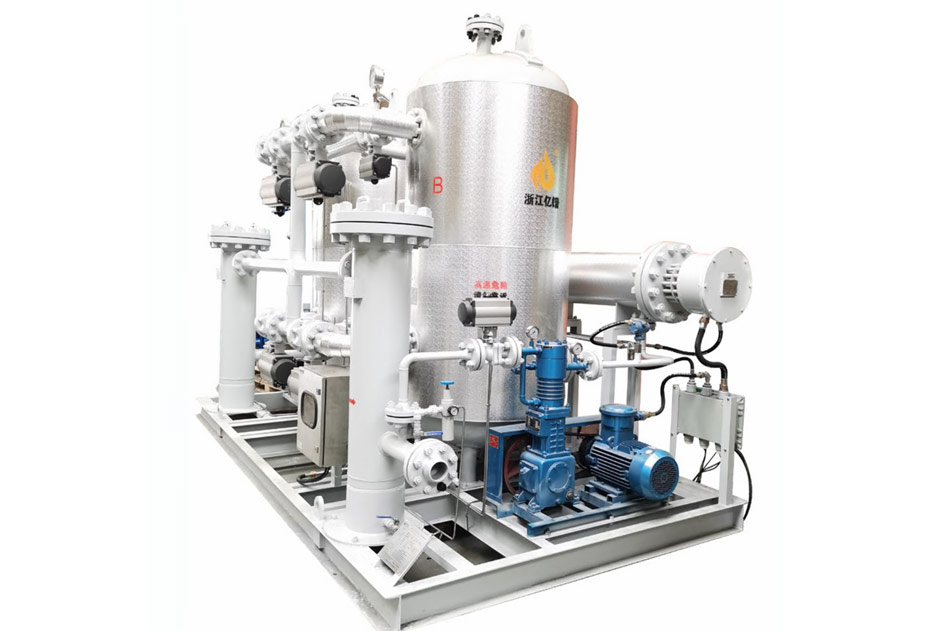Coalbed Methane Dehydration Solutions
Industry Pain Points
Low Pressure and Low Production Constraints: The wellhead pressure of coalbed methane (CBM) is generally below 0.3MPa, causing the efficiency of traditional dehydration equipment to drop by more than 60%. The average daily dehydration cost per well is as high as 800 yuan.
High-Mineralization Corrosion: The mineralization degree of produced water reaches 30-80g/L (Cl⁻ accounts for over 50%), leading to pitting and perforation of stainless steel equipment. Each dehydration device requires maintenance an average of 4 times a year.
Organic Sulfur Poisoning: The content of methyl mercaptan (CH₃SH) ranges from 200 to 5000ppm, rendering molecular sieves completely ineffective within 3 months (the sulfur capacity of traditional adsorbents is ≤1%).
Difficult Operation & Maintenance (O&M) in Remote Areas: CBM fields are mostly located in mountainous areas, with power grid coverage of less than 20%, resulting in a failure rate of over 35% for electrically driven equipment.
System Overview
Through the “ceramic desalination – negative pressure flash evaporation – solar-thermal regeneration” technology chain, Yipu Coalbed Methane Dehydration System overcomes the industry challenges of low pressure, high sulfur content, and high mineralization degree:
- Extreme Pressure Reduction: Enables commercial development value of ultra-low pressure gas wells (0.05MPa).
- Dual Control of Sulfur and Hydrocarbons: Simultaneously addresses dehydration and desulfurization needs, reducing O&M costs by 70%.
- Green Development: Achieves zero carbon emissions throughout the life cycle, supporting ecological restoration in coal mining areas.
In 2024, a methane concentration adaptive system was launched, adapting to 5%-95% CH₄ fluctuations.
Solution Approach
Yipu Coalbed Methane Dehydration Solution
| Module | Technical Highlights | Performance Parameters |
|---|---|---|
| Desalination Pretreatment | Silicon carbide ceramic membrane + self-cleaning scraper | Mineralization degree reduced from 80g/L to 5g/L |
| Negative Pressure Flash Tower | FRP (fiberglass-reinforced plastic) material, resistant to Cl⁻ corrosion | Energy consumption: 0kWh, dew point -5℃ |
| Sulfur-Resistant Adsorption Tower | Dual-bed design, pressure drop ≤0.01MPa | Methyl mercaptan ≤5ppm, dew point -50℃ |
| Off-Grid Energy System | Solar panels + thermoelectric power generation, supporting 24-hour operation | Daily power consumption ≤2kWh (for treating 10,000 Nm³ gas) |
| Intelligent Monitoring | Beidou satellite transmission + AI sulfur capacity prediction | Regeneration cycle prediction error ≤8 hours |
Applicable Scenarios:
- Instant dehydration at low-pressure CBM wellheads
- Coal mine gas drainage stations
- CBM gathering and transportation central stations
Technical Principles
Yipu Four-Stage Sulfur-Resistant Dehydration Process:
- Mineralized Water Pretreatment (Stage 1):The ceramic membrane cyclonic desalter removes 90% of salt (Cl⁻ ≤500ppm) within 0.5 seconds, with an anti-scaling design life of 10 years.
- Negative Pressure Flash Evaporation (Stage 2):Uses wellhead negative pressure (0.05-0.3MPa) to achieve self-driven flash evaporation, cooling the gas from 35℃ to 10℃ without external energy consumption, and reducing the dew point to -5℃.
- Sulfur-Hydrocarbon Synergistic Adsorption (Stage 3):Silicon-aluminum molecular sieve composite bed:
- Upper modified silica gel specializes in adsorbing methyl mercaptan (sulfur capacity up to 8%)
- Lower 3A-CBM molecular sieves achieve deep dehydration to -50℃
- Solar-Thermal Regeneration (Stage 4):Adopts solar heat-collecting tubes + heat storage materials to store energy during the day and regenerate at night, achieving 100% energy saving compared with electric heating.
Core Advantage
| Advantage | Details |
|---|---|
| Customized on Demand | Meets special working conditions; provides professional non-standard customization |
| Low Cost | Adopts cyclic regeneration process; significantly reduces operating costs |
| High Stability | Dual-tower structure with small pressure fluctuation; low noise and continuous gas supply |
| Fully Automatic Operation | Easy to operate, reducing labor input; improves efficiency |
| High Safety | Presets multi-level safety protection measures; supports automatic alarm |
| Low Failure Rate | Maintains low failure rate after 10,000 hours; high durability with almost no maintenance required |
Technical Strength
Leading Adsorption Dehydration Technology
Uses high-performance molecular sieve adsorbents with high water absorption capacity and resistance to corrosion by acidic gases (H₂S/CO₂), ensuring deep dehydration with a dew point ≤-70℃.
The original hot nitrogen regeneration process reduces energy consumption by 30% compared with traditional electric heating regeneration, and integrates a waste heat recovery system to significantly improve energy efficiency.
Modular and Customized Design Capability
Core equipment adopts modular prefabrication, supporting rapid deployment (installation cycle shortened by 50%) and adapting to diverse scenarios such as offshore platforms, onshore gas fields, and LNG pretreatment.
Can customize single-tower, dual-tower, or multi-tower parallel systems according to customer needs, with a treatment capacity ranging from 10,000 to 1,000,000 Nm³/d, flexibly matching gas fields of different scales.
Intelligent Control and Remote Operation & Maintenance
Equipped with a PLC+IoT intelligent control system, it real-time monitors key parameters such as pressure, temperature, and dew point, supporting fault early warning and automatic adjustment.
Through cloud-based big data analysis, it optimizes the adsorption-regeneration cycle, extends the service life of molecular sieves, and reduces O&M costs by 10%-15%.
Energy-Saving and Environmental Protection Technology
Features zero-emission design for regeneration exhaust gas, complying with international environmental standards such as EU CE and US EPA.
Energy consumption is 25%-40% lower than that of traditional triethylene glycol (TEG) dehydration systems, helping customers achieve carbon emission reduction goals.
Long-Cycle Operation Reliability
Molecular sieves adopt anti-pulverization coating technology, with a service life of over 5 years, reducing replacement frequency.
Key components (e.g., valves, instruments) are selected from international first-tier brands (e.g., Siemens, Emerson), with a Mean Time Between Failures (MTBF) of over 100,000 hours.
Strong R&D and Engineering Experience
Possesses more than 19 patents and software copyrights in dehydration technology; the R&D team is led by doctors and has in-depth cooperation with universities and colleges.
Has over 1,000 successful cases worldwide, covering extreme working conditions such as high-sulfur gas fields in the Middle East and low-temperature environments in the Arctic.
Product Advantage Comparison
| Indicator | Yipu System | TEG Dehydration | Refrigeration Method | Competitor Adsorption Systems |
|---|---|---|---|---|
| Minimum Operating Pressure | 0.05MPa | Requires ≥0.3MPa | Requires ≥0.5MPa | Requires ≥0.2MPa |
| Sulfur Resistance | No failure at 5000ppm methyl mercaptan | Requires pre-installed desulfurization | Not applicable | Poisoning at ≥300ppm methyl mercaptan |
| Energy Consumption | 0kWh (fully solar-thermal driven) | 0.25kWh/m³ | 0.15kWh/m³ | 0.1kWh/m³ |
| Mineralization Tolerance | Cl⁻ ≤1000ppm | Requires softening treatment | Scaling at Cl⁻ ≥500ppm | Cl⁻ ≤300ppm |
| Investment Payback Period | 1.2 years (calculated at a gas price of 1.5 yuan/m³) | 3.5 years | 2.8 years | 2 years |
Typical Case
Project Name: Qinshui Coalbed Methane Field in Shanxi
Operating Conditions:
- Single well pressure: 0.08-0.2MPa, methyl mercaptan: 1800ppm
- Mineralization degree: 65g/L, average daily gas production: 8000 Nm³
Dehydration Effect:
- Dew point reduced from saturated state to -55℃
- Adsorbents operated continuously for 32 months without replacement
Economic Benefits:
- Annual savings of 580,000 yuan in electricity and chemical costs
- Annual carbon emission reduction income of 120,000 yuan (from CCER trading)

